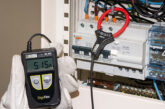
Alexander Bardakov, Field Applications Engineer for the Industrial Imaging Group at Fluke Corporation, offers his top tips for getting the most from your leak detection device.
Choose a device that includes an acoustic imager
Using an acoustic imager that is equipped with a range of ultra-sensitive microphones can provide an expanded field of view. This makes it easier for maintenance teams to locate air, gas and vacuum leaks quickly and accurately in compressed air systems.
Compared to devices that rely on the ability to hear the leak, an acoustic imager can be used in all environments, regardless of noise levels. This saves time when detecting leaks, as there’s no need to wait for production stoppages or other non-working hours.
Observe reflections
You need to be aware of reflected leaks – these are simply reflections of the sound produced by the real leak. They can be identified by the fact that they will appear and disappear as you move the leak detector around. But reflected leaks can also be useful – the reflections can guide you to the leaks for which you have no direct line of sight.
Use frequency settings
Many leak detectors can make use of different frequency settings. Start by using the default settings for the device – 30 kHz to 40 kHz is usually the best range for finding leaks quickly. As you identify a leak, use the control to adjust the frequency span – this helps to pinpoint the leak more precisely.
You can also adjust the range to scan for leaks which do not reveal themselves through default settings, or to improve the visibility of the leak. Adjusting the frequency settings can also allow the leak detector to be used in noisy environments where machines and tools are running at full capacity.
See how much the leak is costing you
One of the most important pieces of information your leak detector can give you is how much that leak will cost if you do not fix it. Some leak detectors have a special function that measures the severity of the leak. The more severe the leak, the higher priority it has for fixing, as it will be costing you more money the longer it remains.
Keep everyone in the picture
As well as seeing the leaks for yourself, you will need to keep your team informed about them. This is why you will want to make sure your device can provide reports that include the image of the leak, asset tags, annotation, leak size and also the severity of the leak.
Asset tagging can be particularly useful. It allows you to keep track of assets, by manually inputting a tag. Using tagged images can allow staff to see trend data on each piece of equipment, allowing them to diagnose issues and send out a crew to maintain it.
All this information can be wrapped into a professional report to share with others, such as repair teams. Images and notes can be added to the work order, ensuring maintenance staff have a complete view of what needs to be done to fix the leak.
View a tech data sheet for Fluke’s II900 Industrial Acoustic Imager here.








